How to Protect & Restrict Content in the WordPress Block Editor
Restricting content is an effective yet underrated strategy that can generate long-term exposure for your WordPress website. You can bring the right flow of attention to content blocks or posts that matter through proper content restriction.
While you can restrict WordPress content by making a post private, you might feel limited by such an approach. Without using any content restriction plugin, you can only modify visibility on a per-post basis.
Thankfully, you can use the advanced visibility conditions offered by Conditional Blocks to restrict your website’s content created in the WordPress block editor. Conditional Blocks’ conditions are no-code and easy to use, which is excellent for beginners and pros alike.
Table of Contents
Restricting Content Using Conditional Blocks
It’s easy to use Conditional Blocks’ conditions to restrict visibility for your WordPress content created with the block editor. In this article section, we will show you how to use some of the popular conditions of Conditional Blocks.
Setting Up A Condition
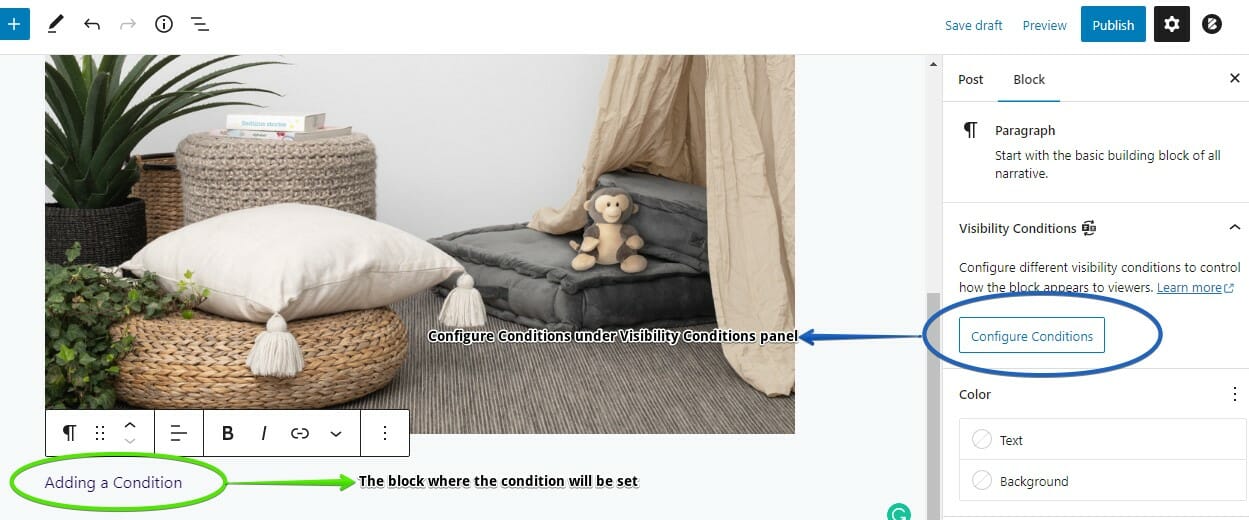
To set up a Conditional Blocks condition, select a content block you want to restrict. Next, choose configure conditions from the Block panel to open the condition builder.
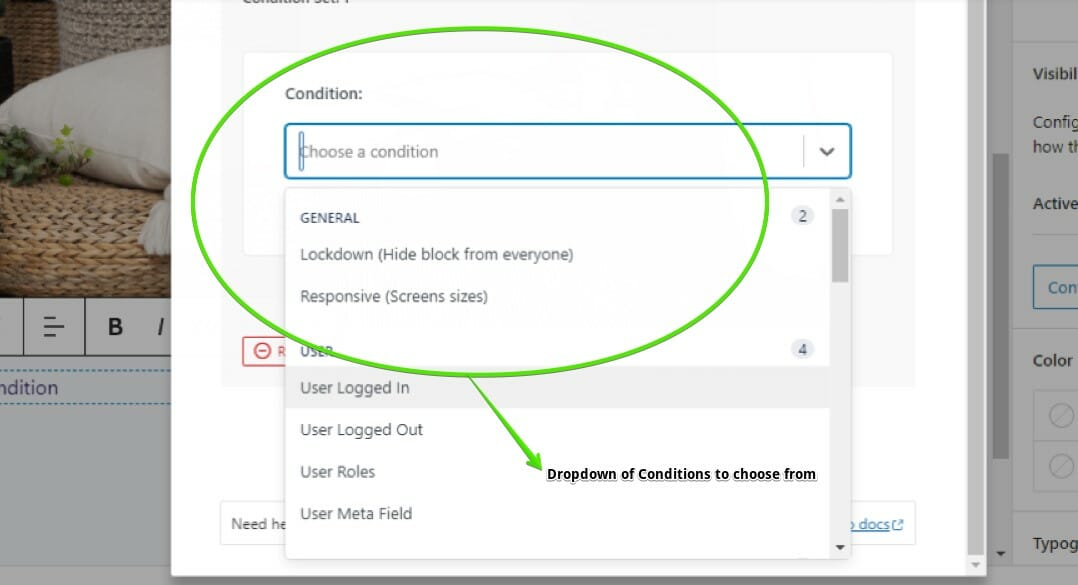
In the condition builder, you can see the dropdown menu containing the numerous conditions offered by Conditional Blocks. Any condition can be chosen, and it’s even possible to combine multiple conditions to achieve unique restriction effects!
The Lockdown Condition (Hide/Show Chosen Blocks)
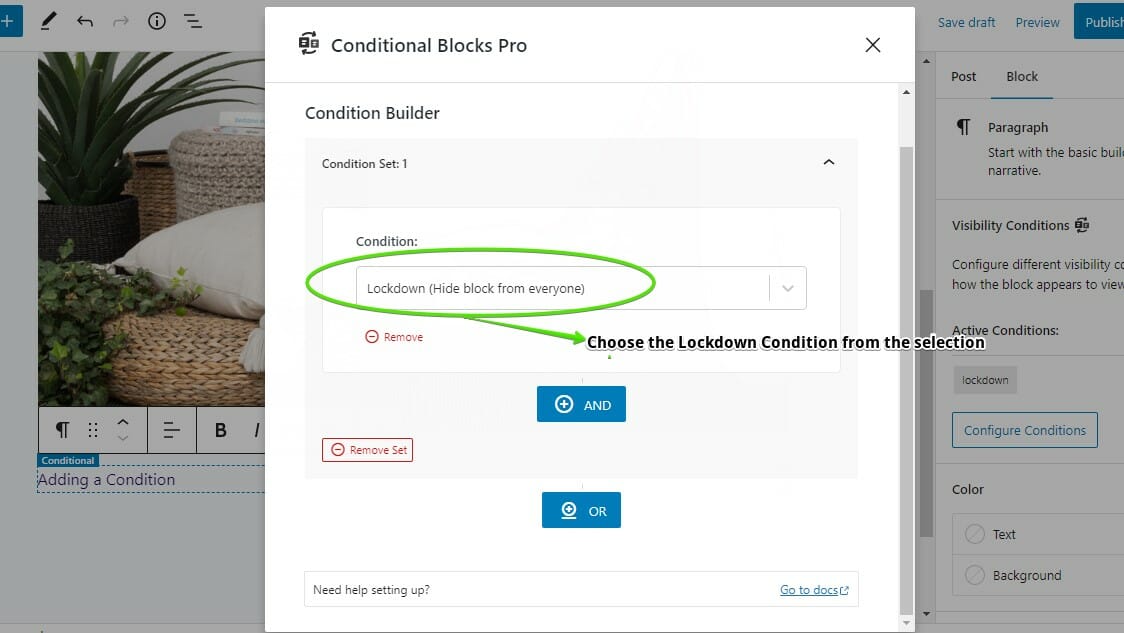
The Lockdown condition is a simple option that keeps a block hidden from readers or visitors. If you want to publish a post but feel that a block is unpolished or unfinished, lock it down. The locked-down block will be isolated from the other content blocks, allowing you to work on it freely without affecting the other blocks.
Once you’re done working with the locked-down block, turn off the condition, and it will become visible again.
The User Role Condition (Restrict Content Based on User Roles)
Now, let’s check out another valuable and exciting option called User Role Condition. The User Role Condition restricts a content block based on the chosen user role.
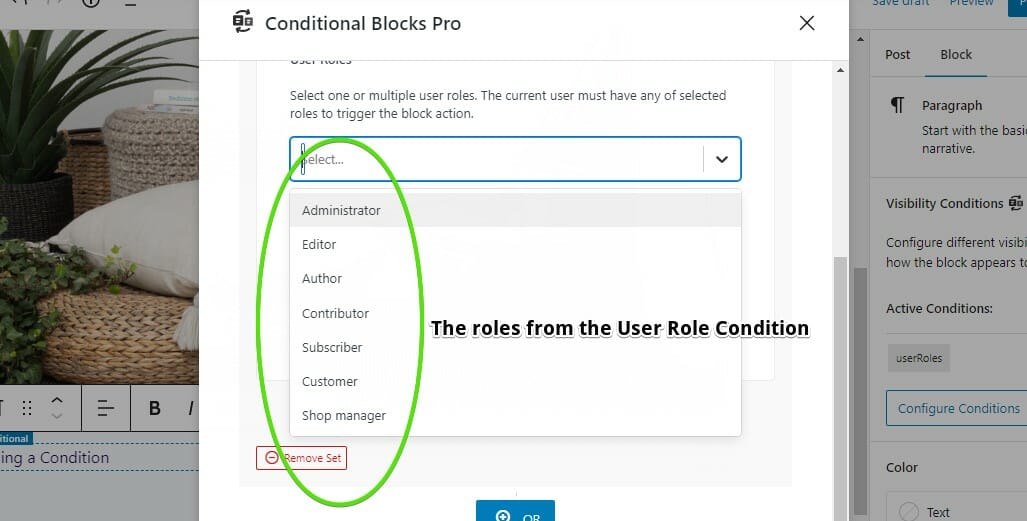
Once you’ve chosen the User Role Condition from the condition builder, you can select one or more roles. Some example roles are Administrator, Author, Member, and Editor. Even third-party user roles from other plugins can be selected.
Afterward, you can set the Block Action to be visible or hidden.
The Membership Plan Condition (Restrict Content Based on Membership)
Thanks to the official integration of ProfilePress and Conditional Blocks, it’s now possible to restrict content created with the WordPress block editor based on the membership plan. Once the Membership Plan Condition has been set, it can make a content block hidden or visible to a site visitor.
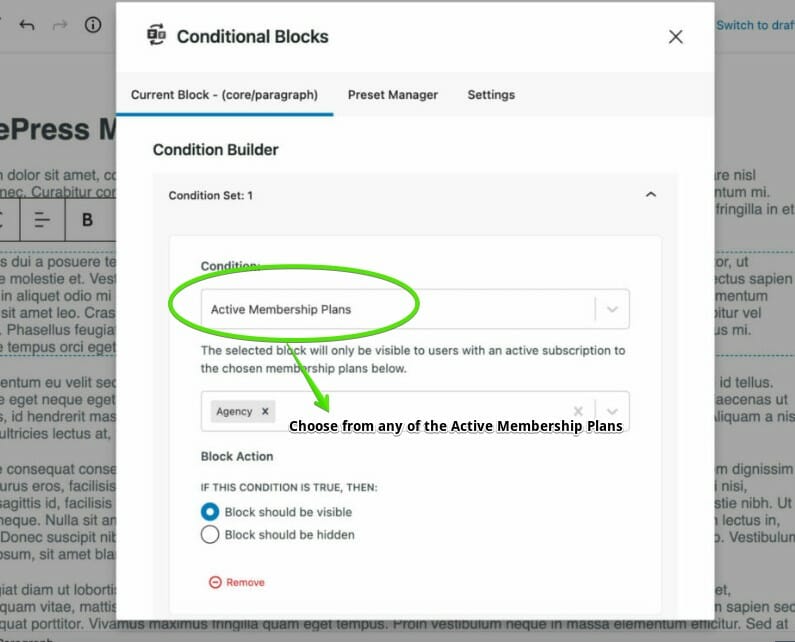
The Membership Plan Condition is flexible enough to work with other conditions offered by Conditional Blocks. Combining the Membership Plan Condition with other conditions allows you to achieve a unique, tailor-made setting to match your goals or preferences.
The Date Schedule Range Condition (Set a Schedule to Restrict Content)
If you plan to set a continuous holiday sale for a few days, you can never go wrong with the Date Range Condition. This condition lets you make a content block visible for a predetermined date range.
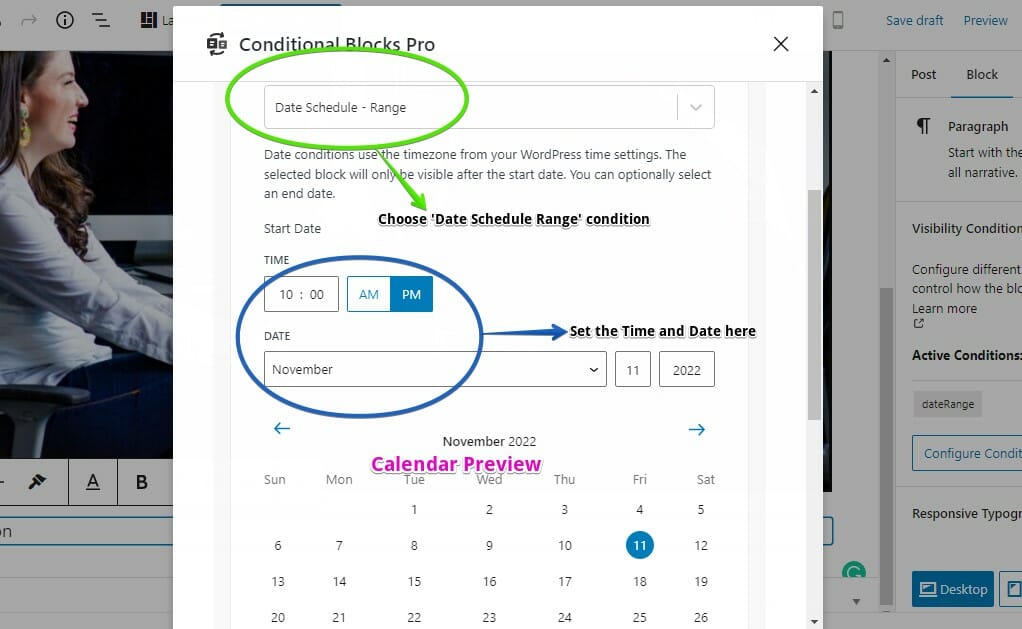
In the condition builder, you can see a small calendar and some fields where you can set the start date and time. Just pick any date and time, and you’re good to go. Once the start date has been set, it will trigger the block to appear indefinitely.
What if you want the visibility of your content block to end? Just set an end date, and the condition will hide the content block indefinitely.
It’s even possible to combine multiple date ranges for a content block! This flexibility is useful for running multiple holiday sales, events, and variable long-term promos.
Benefits of Restricting Content Through Conditions
Using conditions, such as the ones from Conditional Blocks, is similar to having a well-rounded toolkit for a job. Through specific conditions, you can make better effects or integrations that are impossible by using WordPress functionalities alone.
We’ll show you some benefits of using Conditional Blocks’ conditions.
Dynamic Content Visibility Redefined
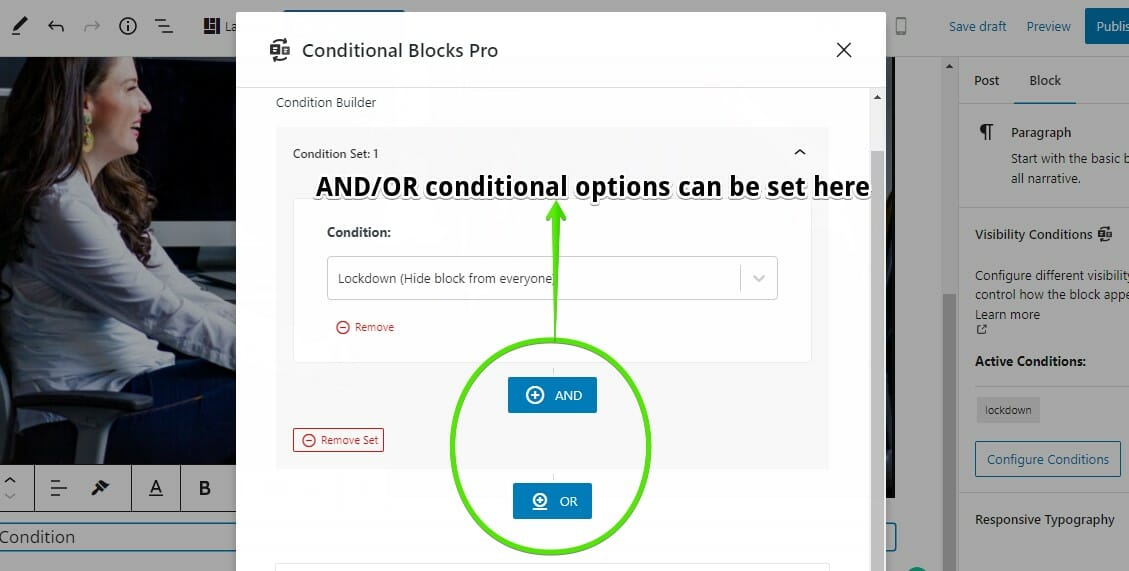
With Conditional Blocks’ conditions, setting in-depth logical integrations is possible in just a few clicks. For example, you can combine two or more conditions to fully customize the visibility settings of a content block.
Here are some combinations that you can make:
- Make a block visible for REGISTERED USERS in any CHOSEN COUNTRY
- Restrict content based on USER COOKIES and their DEVICES
- Utilize fully functional PHP logic for making custom conditions
Real dynamic content visibility can only be achieved using simple yet powerful conditions. By using conditions in a smart way, your content will reach the right target audience strategically.
Efficiency in A Few Clicks
Properly restricted content can increase the efficiency of any WordPress site. If a content block is only visible to hyper-targeted members, it will deliver the right message quickly. This is crucial in fast-paced environments like eCommerce, membership communities, and even sensational blogging networks.
Conditional Blocks’ conditions won’t waste your time. Once you’ve set the appropriate conditions for your blocks, the visibility parameters will trigger as soon as possible. More importantly, the conditions are compatible with Advanced WordPress Blocks, allowing even deeper functionalities.
Best for Nurturing Repeat Businesses
Conditional Blocks’ visibility conditions can also improve repeat businesses for WooCommerce stores by offering WooCommerce conditions. Such conditions can restrict content based on cart value, cart product categories, customer total spent, and geolocation.
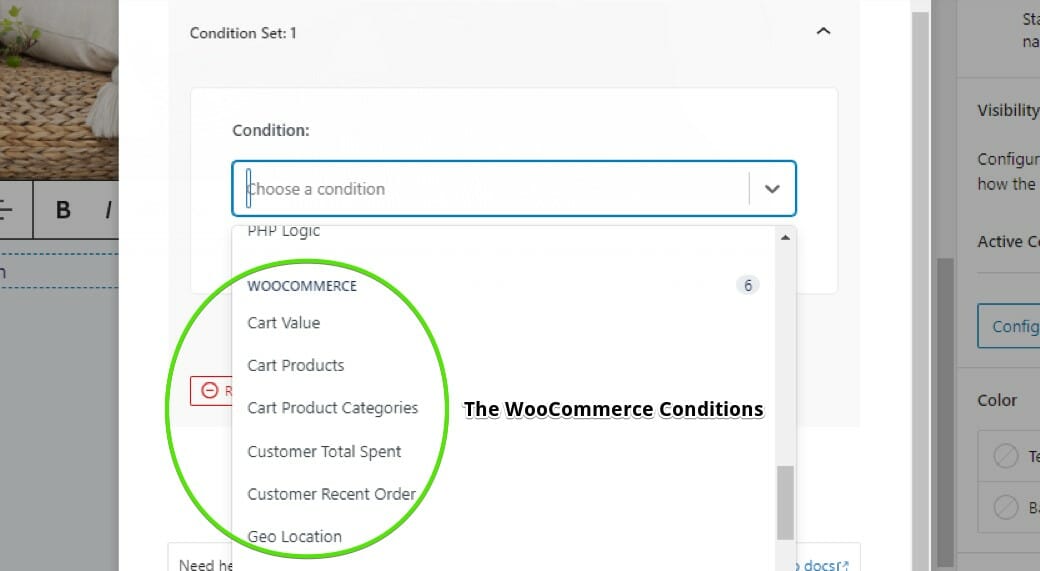
Using WooCommerce conditions for your store will help improve the chance to upsell and cross-sell different products, especially if the ‘promo blocks’ are visible to target buyers. Customers will even become happier if the visible blocks contain useful information or appealing product recommendations.
Conclusion
Even though you can restrict content through the default functionalities of WordPress, you’ll gain a greater advantage by using powerful custom conditions. Such conditions are always available with Conditional Blocks.
Are you ready to restrict content created with the WordPress block editor on your website? Use Conditional Blocks today and check out its capabilities!